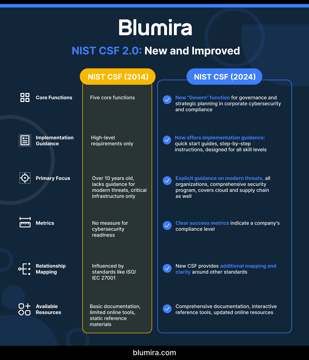According to Deloitte, 70% of state and local governments report that cloud environments are their preferred approach for government cloud security. As a result, state, local, tribal, and territorial governments are increasingly adopting the NIST Cybersecurity Framework as the foundation of their cloud security programs, enabling them to better secure complex and often ephemeral cloud environments.
Though initially designed for federal government agencies, implementing NIST CSF and other NIST Special Publication security requirements helps state and local governments reduce cybersecurity risk and manage systems, applications, and data more efficiently and securely. By following the guidance in the NIST CSF, agencies can develop a cybersecurity plan which enables agencies to procure additional cybersecurity funding from federal entities (such as the State and Local Cybersecurity Grant Program).
Many state and local governments are consistently enhancing their government cybersecurity measures to meet those recommendations, as the National Conference of State Legislatures (NCSL) reports at least 32 states require these lower-level government agencies to have cybersecurity measures in place.
One effective strategy in adhering to the NIST CSF is adopting the right cloud SIEM tool, a move that can significantly uplift the cybersecurity posture of public sector entities. For instance, Ottawa County’s implementation of Blumira’s SIEM solution exemplifies how tailored SIEM tools can meet critical cybersecurity tenets, including NIST 800-171 and 800-53 requirements, through automation, robust integrations, and alert prioritization.
Signs You’ve Found The Right Cloud SIEM
Many cloud SIEM tools exist today, so identifying the “right” tool can seem complex. Grand View Research reports that the SIEM market will continue to expand — at a compound annual growth rate of 14.5% from 2023 to 2030.
So, where should busy state and local government agencies start looking for the ideal tools for their unique security use cases?
To fulfill the five pillars of the NIST Cybersecurity Framework (Identify, Protect, Detect, Respond, and Recover), security teams at state and local governments should ensure their cloud SIEM platforms come equipped with the following features and capabilities:
1. Support for Hybrid Environments and Workflows
Because they must safeguard many years of historical data, state and local governments are often required to maintain legacy systems and technologies, even if they prefer to move everything to the cloud.
The National Association of State Chief Information Officers (NASCIO) shared that 48% of state government IT teams report that most applications still require modernization as many processes rely on legacy tools, environments, and systems. Finding a cloud SIEM tool that provides coverage for hybrid environments helps lean IT teams carry out the following NIST requirements:
- Identify: A cloud SIEM that can also monitor traditional on premises environments grants security professionals visibility into their full digital footprint. Consistent, 24/7 visibility allows even resource-strapped IT teams to identify where they’re most vulnerable.
- Detect: The right SIEM enables state and local government IT teams to continuously monitor their entire tech ecosystems for suspicious activity — such as an administrator requesting access into an environment where they lack authorization or clearance.
2. It’s Purpose-Built for Entities Your Size
One major struggle many IT teams at government organizations face is sorting through SIEM solutions that are more appropriate for enterprise companies. Enterprise-level SIEM solutions tend to require large security teams and budgets — which may not be available in state and local government contexts. Additionally, these types of SIEMs can be unnecessarily complex and cost leaner organizations more time and money than they can afford to expend.
An enterprise-level SIEM can contribute to alert fatigue and inundate smaller teams with false positives. The ideal SIEM — especially for lean teams — only alerts on actual incidents or anomalous activity worth investigating.
A strong cloud SIEM purpose-built for smaller security teams should meet the following NIST requirements:
- Detect: Streamlined SIEMs are more manageable for resource-strapped teams and are key for security detection. They cut through the noise and notify security professionals of the anomalies that matter.
- Respond: When state and local government IT teams have easy access to the alerts that require their attention, they can respond to suspicious activities more efficiently. The best cloud SIEMs have XDR capabilities for automated remediation, minimizing unnecessary human intervention for many threats and attack types.
- Recover: Cloud SIEMs enable early intervention for incidents, which helps mitigate the impact of any actual breaches. When small government organizations can detect and respond faster, they can also recover faster.
Additionally, a cloud SIEM that is a good fit for state and local governments will help these entities meet NIST 800-171 requirements, which is necessary for any non-federal entities collaborating with federal-level government agencies. SIEMs, when appropriately structured for leaner IT teams, help meet and exceed the expectations for logging, monitoring, threat detection, and response.
3. Compatible With Existing Tools, Technologies, and Infrastructures
State and local governments also need a cloud SIEM that won’t break or compromise the performance of their existing processes, technologies, and technical infrastructures. State and local governments must work with legacy systems, not just the cloud. So, they need tools that are compatible with hybrid environments.
NASCIO reported that state IT leaders view modernizing and reimagining the government workforce’s role in implementing and using technology as a top three priority. A cloud SIEM that’s easy for non-security personnel to use can be an effective stepping stone in those modernization goals.
It’s also crucial for the cloud SIEM to require minimal time, effort, and resources for setup. The faster the solution can get up and running, the quicker organizations will see ROI.
When cloud SIEMs are easily integrated with existing solutions, they help enable these pillars of NIST CSF:
- Identify: Cloud SIEMs that connect with an organization’s existing tech stack help identify incidents that can arise from shadow IT.
- Detect: Cloud SIEMs that integrate and access other tools, tech, and infrastructures enable better detection by expanding what types of cloud activity can be monitored. This allows IT teams to monitor cloud-based services, Internet of Things (IoT), and software configurations, as recommended in the current initial public draft of NIST CSF 2.0.
Blumira: Your Ideal Cloud+ SIEM
State and local government IT teams need a cloud SIEM that meets their specific needs without overstretching their capacity. They need a solution that can help drive digital transformation while continuing to protect and safeguard civic information and processes. That’s where Blumira comes in.
Our platform frees up time and resources, allowing local government cybersecurity professionals to reduce unnecessary tasks and focus on critical civil services and protection initiatives. Blumira’s cloud SIEM comes with automatic alert prioritization, which makes it easy for analysts to triage what matters — and reduces alert fatigue. Plus, our lightweight, frictionless solution can be installed in minutes and requires no additional infrastructure or unnecessary effort on your team’s part.
We built Blumira with public sector teams like yours in mind. That’s why our easy-to-use platform is efficient, effective, and, maybe most importantly, simple.
- CTA: Learn more about how Blumira’s security solution supports state and local governments
Additional Resources
For additional guidance in choosing the right cloud SIEM for NIST, state and local government IT teams can reference:
NIST SP 800-210, which contains the following recommendations for implementing a solid cloud security program:
- Employ policies and predefined roles to manage access rights to applications and underlying databases
- Design a flexible or real-time mechanism for assigning and revoking privileges to maintain cloud usability
- Maintain and identify necessary security boundaries in virtualized environments
NIST 800-171, which contains the following recommendations on working with Controlled Unclassified Information (CUI) for non-federal entities interfacing with federal-level government agencies:
- Isolate CUI into its own architectural domain for easier logging and monitoring
- Sanitize or destroy systems containing CUI before disposal or release for reuse
- Control access to media containing CUI and maintain accountability when transporting from controlled areas
NIST 800-53, which contains the following recommendations for any contractors or entities conducting business with the federal government:
- Develop rigorous security system life cycle management
- Enable continuous monitoring of information systems to track the effectiveness of controls
- Divide controls into common, system-specific, or hybrid families based on their implementation
The State and Local Cybersecurity Grant Program, developed by CISA and FEMA to provide funding supporting cybersecurity programs, solutions, and strategies.
More from the blog
View All Posts
NIST Cybersecurity Framework Implementation for Mid-Market Companies: 2025 Update
Read More
Customer Story: District of Sparwood
Read More
Security expert Nick Brigmon discusses Florida’s new cybersecurity standard bill
Read MoreSubscribe to email updates
Stay up-to-date on what's happening at this blog and get additional content about the benefits of subscribing.